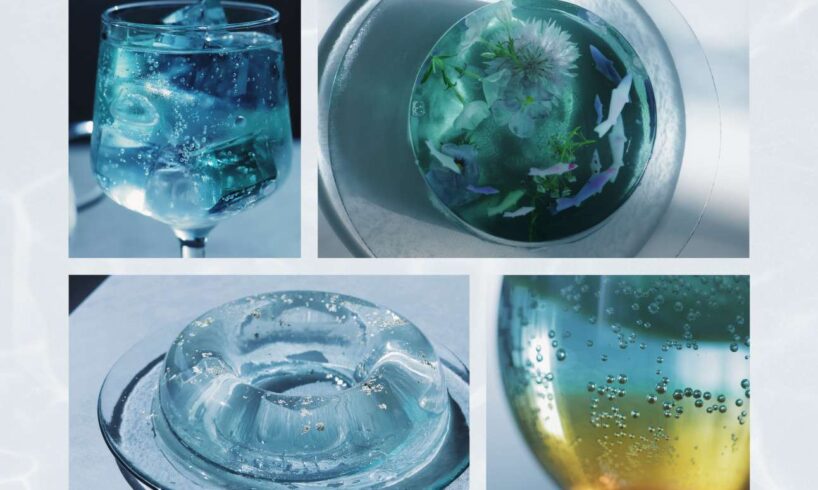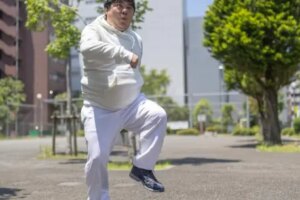
This article was originally published as “Artist Tomei and the Beauty of Clear Things” and “Aesthetic Recipe: Edible Pond Jelly Inspired by Claude Monet” in Metropolis Magazine, “Water” Summer 2025. Read the full issue here.
Obsession with Clarity: Aesthetic Recipes and Beyond
Tomei doesn’t remember exactly when it began; only that from the moment she became aware of the world around her, she was already mesmerized by the ripples on water, the waves of the ocean and the surface of a pool shimmering in light. She’s always been drawn to the transparent.
Even as a child, she collected sea glass and marbles. Today, her job title is tomei aikoka—a transparency aficionado. Her favorite color, she says, is “clear.” She often returns to a line by Antoine de Saint-Exupéry: “L’essentiel est invisible pour les yeux.” What’s essential is invisible to the eye. Water has no shape or color, yet it’s omnipresent and vital. She says it’s this contradiction of knowing something is there but not being able to see it, that continues to draw her in.
Tomei first gained attention through her ethereal recipe videos, which she started posting in 2019, often featuring aesthetic jellies. Her repertoire now includes everything from wagashi and kohakuto (Japanese crystal candies) to soda floats, on which she has published a book. Photography and videography are more than just ways to document her recipes: they are mediums for translating her love of clarity into visual art.
She now curates and collects: objects, art, music playlists and fragments of everyday life seen through her lens. She also writes and takes on creative direction. Her newest venture includes launching a jewelry line. While transparency might sound like a specific and niche obsession, it’s surprisingly omnipresent and expressible across diverse mediums. Her work is multidisciplinary, yet unmistakably cohesive.
In Conversation With Tomei
Do your aesthetics influence how you live day to day?
Yes. Even when it comes to daily items or room decor, I tend to collect transparent things, often without realizing it. I’ve probably gathered over a hundred by now. But they’re not carefully displayed like collector’s items; they’re just quietly woven into my everyday life.
As for clothing, I find myself reaching for white more and more. White pairs beautifully with transparency, and it holds deep meaning in Japanese culture. It represents purity, and has long been essential in Shinto tradition. Brides wear a white kimono to mark a new beginning, and the deceased are wrapped in white as they depart this world without impurity. It’s a color used from start to end, in both celebration and farewell. It is rich in meaning, yet ambiguous.
Is there a place in Tokyo you’d recommend? Somewhere that captures the kind of atmosphere you love?
One of the places I recommend is the Museum of Contemporary Art Tokyo. There’s a quiet space beneath the main exhibition area called the “Water and Stone Promenade.” It’s not a display per se, but the way light flickers across the surface of the water and the shadows of the stones shift softly is ethereal. On sunny days, waves of light ripple across the ceiling, and it lingers with you like an afterimage. I also really love the neighborhood it’s in: Kiyosumi-Shirakawa. It used to be a thriving waterway hub during the Edo period, lined with warehouses. Many of those old warehouses have been transformed into cafés or galleries, and over time, the area has revived into a place where people gather again.
Do you have any favorite seasons?
Lately, I’ve come to love early summer, especially that moment just before the rainy season begins. The temperature starts leaning into summer, and you can smell the moisture in the air, but the sky still holds traces of spring.
Japanese has so many beautiful words to describe this season’s rain. Haku-u refers to a sudden evening downpour in summer, when it’s still bright outside and the rain hits the ground with such force that it rebounds as mist, making the air appear white. Ryoku-u describes rain that falls gently over the fresh green leaves of early summer, making the greenery appear even more vibrant and glossy. The fact that each kind of rain has its own name shows just how closely people in the past attuned themselves to its sound, scent and texture.
“Claude Monet’s Pond” Jelly
Make a dreamy dessert in the impression of Monet’s jardin d’eau, complete with water lilies and koi fish.
Ingredients
For Water Lilies
・Edible Flowers (soaked in sugar water) — as needed
For Koi Jelly
・300ml lactic drink (like Calpis)
・3g agar powder
・30g granulated sugar
・Food coloring (red, black, yellow) — a little of each
For Pond Jelly (Umeshu Layer)
・450ml water
・150ml umeshu (plum wine)
・60g granulated sugar
・Gelatin sheets — 12g (soaked in water for 1–2 minutes before use) Food coloring (blue, green, black) — a little of each
Instructions
1) Make the koi jelly:
Heat the lactic drink and agar powder in a saucepan until just before boiling. Add the sugar and stir until dissolved.
2) Color and set:
Strain the mixture and pour a little into four small containers. Add drops of food coloring to create koi-like patterns, and chill in the fridge until firm.
3) Cut out the koi:
Use a small fish-shaped cutter to punch out the koi jelly shapes. Keep them in the fridge.
4) Make the pond jelly:
In a saucepan, heat the water and umeshu. Gradually add food coloring until the liquid takes on a gentle, watery hue. Add sugar and stir to dissolve.
5) Add the softened gelatin sheets to the warm liquid and stir until completely melted.
6) Remove from heat and place the saucepan in an ice bath to cool slightly.
7) Assemble in layers:
Pour a thin layer of pond jelly into a mold, and place the koi jelly and edible flowers on top. Chill to set, then repeat this step 2–3 times to create a floating effect.
8) Once fully set, briefly dip the mold in warm water to release the jelly.
9) Finishing touches:
To finish, gently press plastic wrap over the surface of the jelly and chill for five minutes. This creates a soft ripple texture, just like a real pond.
Watch the full recipe video by Tomei here: “Edible Pond” Jelly Inspired by Claude Monet
To see more of her transparent world, visit her Instagram.
Like aesthetic things and Japan? You might enjoy these articles too:
Sento Architect Kentaro Imai and the Art of Bathing Spaces
Based in Japan: How Mateusz Urbanowicz Preserves Tokyo’s Spirit Through Watercolor
This Kyoto Bar is a “Sound Forest” Filled with Ambient Music and Exotic Plants





